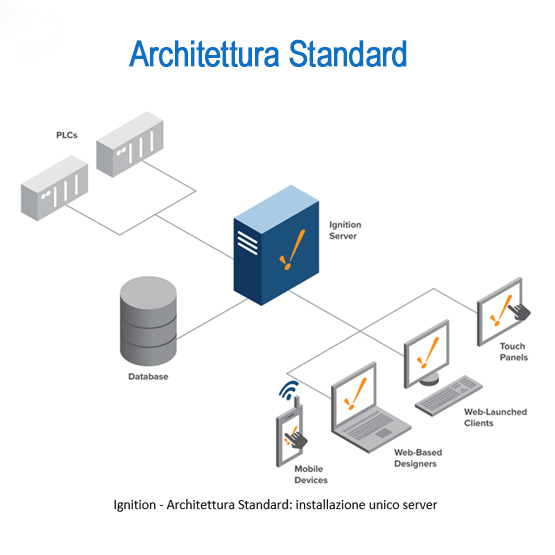IGNITION
The Ignition platform, produced by Inductive Automation, is an evolution of SCADA that also allows HMI and MES software to be created in a single system. This centralization in a single platform allows you to easily control processes and track, visualize and analyze all data, without limits. All this thanks to an open architecture (uses Java and SQL databases), scalable (programmable in Python), web – based (HTML5 and CSS3) and cross – Platform (Windows, Linux and MacOS). Furthermore, with the use of the new Perspective module, native web applications can be developed for the industrial world, with a responsive view, allowing processes to be monitored from any device.
The Ignition work environment is divided into main modules and additional modules. Each module provides a functionality in the system and they all integrate perfectly to build the desired application.
ENTERPRISE ADMINISTRATION module
The Enterprise Administration Module (EAM) provides a secure and intuitive way to manage many Ignition installations from a single location. It is ideal for large companies deploying multiple gateways across vast geographic distances, but even companies with just a few Ignition gateways on a single facility can benefit from its ability to synchronize projects, monitor performance, automate backup and restore from one location or central station.
PERSPECTIVE module
Ignition Perspective is optimized for mobile devices, enabling you to create the next generation of responsive web applications for the industrial world. It is a completely new module, designed to enable the creation of responsive mobile applications, functioning natively on any handheld device or web browser. Perspective is fully compatible with HTML5 and CSS3, allowing you to exploit the full power of the device's touch inputs and, if used via the Mobile App, it also allows direct access to the integrated sensors (GPS, video camera, accelerometer, etc.). With Ignition Perspective you can easily design complex page layouts that automatically adapt to different screen sizes, all in a single design environment: Ignition Designer.
Modulo SQL BRIDGE
The Ignition SQL Bridge module uses the power of SQL (Structure Query Language) databases and lets you take advantage of Ignition's unlimited tags and database connections. The main features are:
Move data bidirectionally, from any data source (PLC, OPC server, etc.).
Record data in the database easily.
No data loss.
Automatic creation of tables on the database.
VISION module
The Vision module allows you to create dynamic HMI pages for viewing and analyzing historical and real-time data, represent interactive graphs and tables so you can analyze data at a glance and act quickly when necessary. Since all clients are connected to the central server, anyone will constantly have access to updated data.
REPORTING module
Quickly and easily create rich, dynamic PDF reports. The Ignition Reporting module is a standalone solution that simplifies and improves the Reporting process from start to finish. The offer for IT Services includes:
Generate reports from existing files or create them from scratch.
Extracts data from a variety of sources and designs reports with easy-to-use interfaces.
Allows you to add charts, tables, forms and other components.
Reports can be saved in PDF, HTML, CSV file formats and report generation and automatic saving can be scheduled.
ALARM NOTIFICATION module
This module allows you to configure the sending of alarm notifications via email, SMS and voice calls:
By configuring the alarm notification sending logic.
Managing the users it needs to be sent to and ensuring timely delivery.
Allow bidirectional notification sending between user and system.
TAG HISTORIAN module
This module allows you to transform any SQL database into a high-performance Tag Historian. A Tag Historian is a storage of the temporal evolution of a Tag that comes from some device from the field device. The power and ease of use of the Tag Historian module make it the ideal choice for archiving historical information for any organization. It is also possible to draw graphs representing the temporal evolution of these Tags using components of the Vision and Perspective module.
Ignition is flexible enough to meet the needs of any enterprise infrastructure whether large, medium or small. You can deploy Ignition to one site, multiple sites, or host it in the Cloud. The architecture can be either standard or IIOT type.
The basic architecture of Ignition is a single server installation. This is very simple to set up and provides the powerful Ignition Gateway functionality and can serve as a starting point for more complicated architectures. The standard architecture consists of a single gateway that can connect to multiple PLCs, databases and other devices, all with a single installation. Plus, it's easy to add new devices, databases, clients, touch panels, workstations, and even mobile devices, all from a single Ignition installation.
Ignition can collect data from any device in the network, publish it to a central broker (MQTT server), and send it to industrial applications and lines of business subscribed. The IIOT architecture typically involves the use of the MQTT protocol to communicate with a large number of devices. MQTT is a lightweight and secure protocol that uses a single publish/subscribe transport method. The data collected by the MQTT Server can be stored and presented in a client with the Vision module or via reports with the Reporting module.




